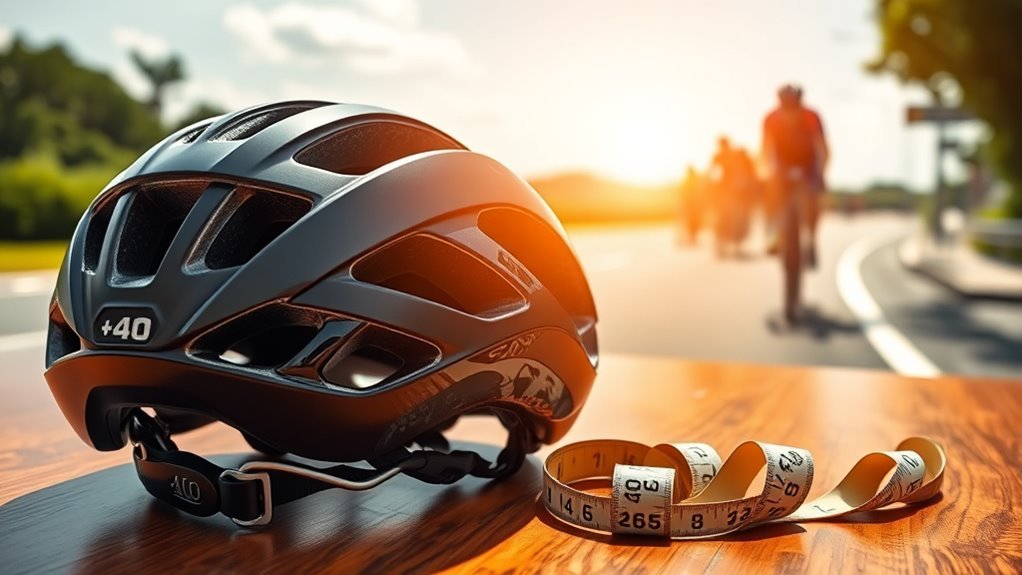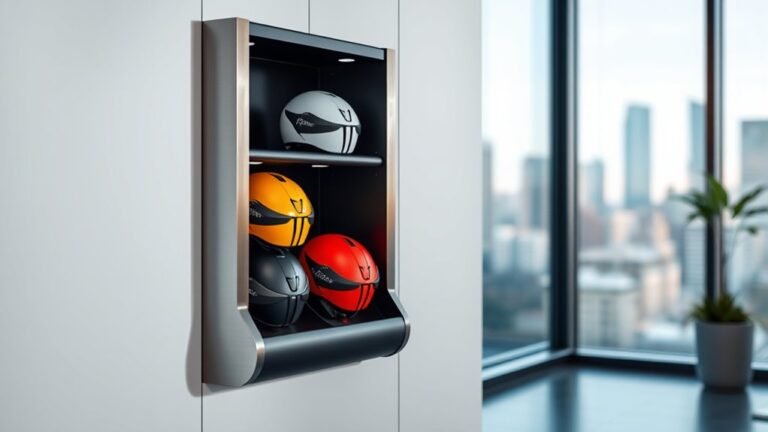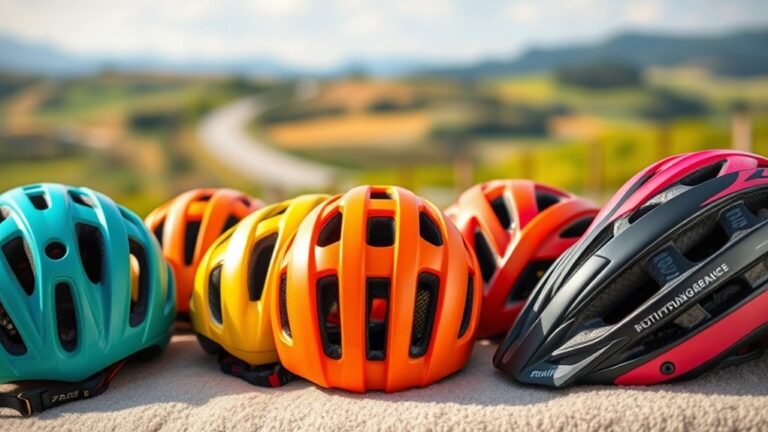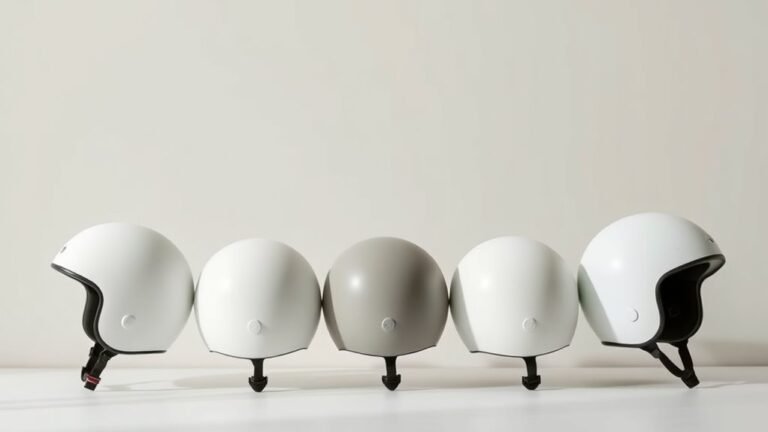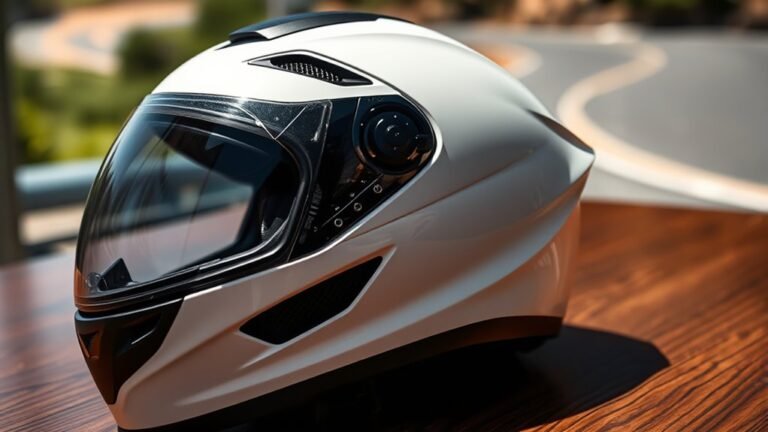How to Choose the Right Bicycle Helmet for Road Cycling
When choosing the right bicycle helmet for road cycling, prioritize safety by selecting one with CPSC, EN 1078, or Snell certifications. Ascertain a proper fit by measuring your head and adjusting the chin straps for snugness. Look for helmets with effective ventilation and lightweight design for comfort during long rides. Additional features like MIPS technology and reflective elements can enhance safety. Want to discover more tips for selecting the ideal helmet? Keep exploring your options.
Understanding Helmet Safety Certifications
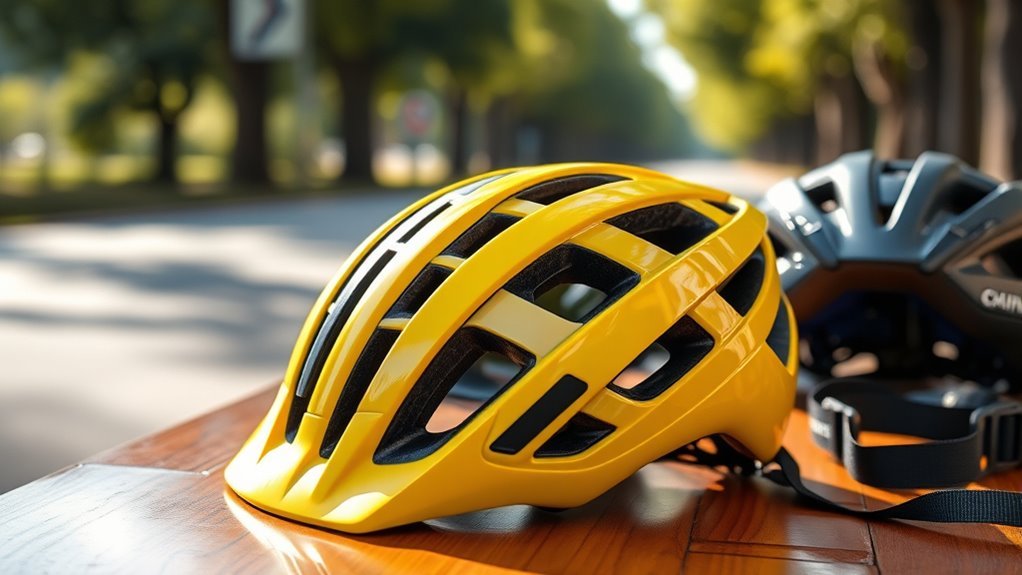
When it comes to choosing a bicycle helmet for road cycling, how do you know which safety certifications matter? Understanding helmet safety certifications is essential for ensuring your protection. Look for certification labels like CPSC, EN 1078, or Snell, as these indicate adherence to specific safety standards. Each label signifies that the helmet has undergone rigorous testing for impact resistance and durability.
CPSC is the U.S. standard for bicycle helmets, while EN 1078 is commonly recognized in Europe. Snell certification goes beyond basic requirements, ensuring even higher performance. By selecting a helmet with these certification labels, you’re choosing freedom on the road with the confidence that you’re protected against potential injuries. Prioritize safety, and enjoy your ride with peace of mind.
Importance of Proper Sizing
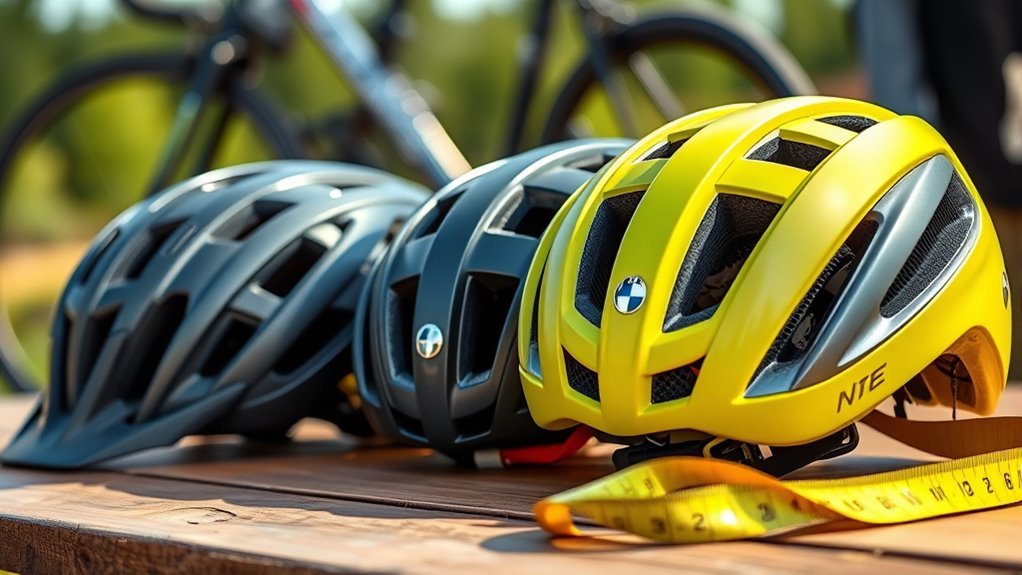
Proper sizing of your bicycle helmet is essential for ensuring maximum protection and comfort. When your helmet fits correctly, it stays securely in place, reducing the risk of injury during a fall. Start with proper measurement by using a tape measure around the widest part of your head, just above your ears. Once you have that number, explore various fitting techniques, like adjusting the chin strap and internal padding. Aim for a snug fit; you shouldn’t be able to move the helmet more than an inch in any direction. Remember, a well-fitted helmet not only enhances your safety but also allows you to ride freely, giving you the confidence to tackle those long road cycling adventures.
Different Types of Bicycle Helmets
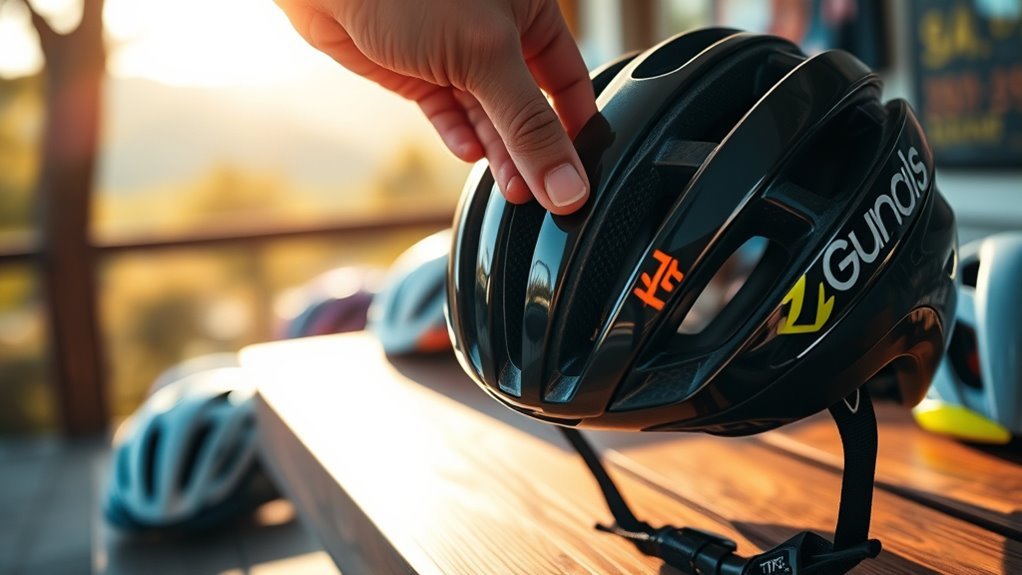
Choosing the right type of bicycle helmet can greatly impact your riding experience and safety on the road. If you’re tackling rugged trails, mountain helmets are designed with added protection and a visor to shield your eyes from debris. These helmets often feature a more robust construction to withstand impacts. On the other hand, if you’re commuting through city streets, commuter helmets prioritize lightweight comfort and ventilation. They usually come with reflective materials for visibility and often include features like integrated lights. Knowing the differences between these helmets helps you select one that aligns with your riding style and environment, ensuring you enjoy the freedom of cycling while remaining safe and secure. Choose wisely, and let the road be your playground!
Evaluating Ventilation and Comfort
Ventilation and comfort are essential factors to contemplate when selecting a bicycle helmet for road cycling. A good helmet should feature effective ventilation systems that allow airflow, keeping you cool during long rides. Look for models with multiple vents strategically placed to maximize air circulation without compromising safety.
Equally important is the comfort padding inside the helmet. Quality padding not only enhances fit but also absorbs sweat, ensuring you stay comfortable on hot days. Consider helmets with removable and washable liners for added convenience.
Ultimately, finding the right balance between ventilation and comfort can greatly enhance your cycling experience, allowing you to focus on the road ahead and enjoy your ride to the fullest.
Considering Weight and Aerodynamics
When it comes to road cycling, every ounce counts, and the weight of your helmet can greatly impact your performance. Opting for helmets made from lightweight materials guarantees you’re not carrying unnecessary weight on your rides. A lighter helmet allows for increased speed and less fatigue, especially during long distances.
Additionally, consider the aerodynamic design of the helmet. A well-structured helmet minimizes drag, enabling you to slice through the wind more efficiently. Look for features like a sleek shape and strategically placed vents that maintain airflow without compromising aerodynamics. Choosing a helmet that balances both lightweight construction and aerodynamic efficiency can enhance your cycling experience, giving you the freedom to push your limits while staying safe on the road.
Exploring Additional Features
Beyond weight and aerodynamics, there are several additional features that can greatly enhance your cycling experience. Look for helmets equipped with advanced technology, such as MIPS (Multi-directional Impact Protection System), which adds an extra layer of protection against rotational forces during impacts. Ventilation is another vital feature; well-placed vents can improve airflow, keeping you cool on long rides. Consider adjustable straps and fit systems for a snug, personalized fit, which can enhance comfort and safety. Some helmets even come with integrated lights or reflective elements, boosting visibility in low-light conditions. By prioritizing these additional features, you’ll not only elevate your comfort but also guarantee a safer and more enjoyable ride on the open road.
Choosing the Right Style for Your Needs
When choosing a bicycle helmet, it’s essential to understand the different types available and how they fit your needs. You’ll want a helmet that not only offers the right level of protection but also guarantees comfort for long rides. Let’s break down the options to help you find the perfect match for your cycling style.
Helmet Types Overview
Selecting the right type of bicycle helmet is essential for your safety and comfort while road cycling. There are various helmet types designed to suit different riding styles and preferences. For instance, lightweight racing helmets prioritize aerodynamics and ventilation, while endurance helmets often feature enhanced padding and comfort. Look for helmets made from advanced helmet materials like in-mold polycarbonate shells, which provide superior protection without excessive weight. Additionally, keep an eye on design trends; sleek, minimalist aesthetics are popular among road cyclists, but vibrant colors can also showcase your personality. Ultimately, the right helmet type will reflect both your riding style and personal taste while ensuring you feel confident on the road.
Fit and Comfort
Finding the right fit for your bicycle helmet is essential for both safety and comfort during your road cycling adventures. A properly fitted helmet should sit snugly on your head without being overly tight. Look for helmets with fit adjustments, allowing you to customize the size for a secure feel. Additionally, consider helmets made with comfort materials like moisture-wicking liners and breathable padding, which enhance your riding experience. These features guarantee that the helmet stays comfortable over long distances while effectively managing sweat. Remember, a well-fitted helmet not only protects you but also gives you the freedom to focus on the road ahead, enhancing your overall cycling enjoyment. Prioritize fit and comfort to elevate your cycling experience.
Maintaining and Caring for Your Helmet
To guarantee your helmet remains in top condition, regular cleaning is essential. Use mild soap and water to wipe down the exterior and interior, removing sweat and grime that can degrade materials. Additionally, proper storage is vital; keep your helmet in a cool, dry place away from direct sunlight to prevent damage.
Regular Cleaning Practices
While it’s easy to overlook helmet maintenance, regularly cleaning your bicycle helmet is essential for both hygiene and longevity. Aim to clean your helmet at least once a month, or more frequently if you ride often or in dusty conditions. Use mild cleaning solutions, like soapy water or specialized helmet cleaners, to avoid damaging the materials. Gently scrub the outer shell and the interior padding, being careful not to soak any electronic components if your helmet has them. Rinse thoroughly and dry with a soft cloth. Regular cleaning not only prevents odor buildup but also helps you spot any wear or damage early, ensuring that your helmet remains safe and ready for your next ride. Keep your helmet fresh and functional!
Proper Storage Techniques
Proper storage of your bicycle helmet is essential for maintaining its integrity and ensuring longevity. By following these proper helmet storage practices, you can keep your helmet in peak condition, ready for your next ride.
- Avoid direct sunlight: Store your helmet in a cool, dry place away from direct sunlight to prevent material degradation.
- Use a helmet bag: A protective bag shields it from dust and scratches, particularly during seasonal storage.
- Inspect before storage: Check for any damages or wear. Addressing issues promptly will extend your helmet’s life.
When to Replace Your Helmet
Knowing when to replace your helmet is crucial for your safety on the road. A typical helmet lifespan is about three to five years, depending on usage and care. However, you should replace your helmet sooner if you notice any signs of replacement, such as cracks, dents, or a frayed strap. Even minor impacts can compromise the helmet’s integrity, so if you’ve been in a fall, it’s best to get a new one. Additionally, if your helmet feels loose or uncomfortable, it may no longer provide the necessary protection. Prioritizing your safety means regularly evaluating your gear and being proactive about replacements. Freedom on the road starts with confidence in your equipment, so don’t overlook your helmet’s condition.
Frequently Asked Questions
Can I Wear a Hat Under My Bicycle Helmet?
You can wear a hat under your bicycle helmet, but it depends on the hat’s compatibility with your helmet’s fit. Make certain the hat isn’t too thick, as it could compromise the helmet’s snugness, reducing its protective capabilities. A thinner cap or cycling beanie can provide warmth without affecting the fit. Always make sure your helmet sits securely on your head, as safety should be your top priority while enjoying your ride.
How Much Should I Spend on a Good Helmet?
When it comes to helmets, you’re investing in your safety—don’t skimp on quality. Expect to spend anywhere from $50 for budget options to $300 or more for helmets with premium features. A helmet that fits well and has good ventilation is essential. Remember, it’s not just about price; it’s about protection and comfort. Think of it as buying peace of mind while you enjoy the freedom of the open road.
Are There Helmets Specifically Designed for Women?
Yes, there are helmets specifically designed for women. These helmets often feature unique ventilation systems and lighter weights to cater to different head shapes. Women’s helmet features may include softer padding and adjustable straps for a better fit. It’s essential to recognize the fit differences, as a properly fitting helmet enhances comfort and safety. Choosing a women’s-specific helmet can provide you with both style and performance while enjoying your freedom on the road.
Can I Customize the Colors or Designs of My Helmet?
Absolutely, you can customize the colors or designs of your helmet! Think of it like painting your own masterpiece; your helmet can reflect your personality. Many brands offer a range of color options and even custom design services. You can mix and match colors to create a look that’s uniquely yours. Just remember, while style is important, safety should always come first. So, choose a design that complements both your flair and protection.
Is It Safe to Buy a Used Bicycle Helmet?
Buying a used bicycle helmet isn’t generally safe. Helmets can degrade over time, and you can’t be sure if a used helmet meets current safety standards. Cracks or unseen damage could compromise its effectiveness in an accident. While it might seem like a budget-friendly option, your safety is paramount. Investing in a new helmet guarantees you’re protected with the latest technology and design tailored for maximum safety on your rides.
